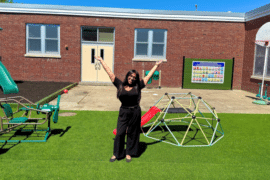A Teacher’s Guide to Beating the Winter Blues
One of my teacher mentors once advised me, “Don’t try to make any rational decisions in the months of February or March. Seriously, don’t even buy a pair of shoes. You’ll regret it later.” Even though, a little retail therapy often feels like exactly what you need to help in beating the winter blues!
Over my 17 years of teaching, I have found these to be wise words indeed.
What is it about those wintery months that are so exhausting for teachers, especially mentally? It is estimated that at least 5% of adults in the US suffer from Seasonal Affective Disorder and an even larger percent suffer from less severe versions of the “winter blues.” Combine that with unmotivated students who just want to fast-forward to spring break. It can be hard for some teachers to stay positive and motivated.
In 2021 add in a raging global pandemic that is forcing many schools to move from in-person learning to virtual to hybrid, back to virtual, etc. Many teachers have pivoted so many times, we’re already dizzy and exhausted.
I think this is why we need to approach these notoriously tough winter months with a solid plan of action. How can we imbue these days with some joy and light to make them more bearable? Here are a few things that have worked for me in the past or that I plan to do more of this year. Maybe they can help lift your spirits in the upcoming months, too.
- Listen to LOTS of music.
Two years ago, I started a new morning routine. Every morning when I got to school I left the florescent lights in my classroom off and just turned on my desk lamp. Then I connected my cell phone to my speakers and started playing some tunes. I tended to lean toward relaxing playlists or upbeat songs. I would listen right up to when students started arriving, and then something interesting happened: students started asking me to leave the music on while they were getting settled and doing bell work. It improved their mood as well, which was an added bonus.
Now that I’m teaching virtually, I start every Zoom session with music. I have used simple Google forms to gather song suggestions from my students. I try to keep all songs upbeat and positive. It is an easy way to start a class off on a good note.
- Sit in direct sunlight.
Several of my colleagues and I used to crowd into the small, florescent-lit staff room at lunch to eat and kvetch about the events of the morning. Last winter we decided to move the party to the school lobby, which has floor-to-ceiling windows and sunlight beaming in during the noon hour. Despite some of us needing to wear sunglasses to keep from being blinded, we all agreed the change of scenery was refreshing.
Now that I’m teaching virtually, these lunches aren’t possible. However, I still try to sit near a window whenever I can or on my front porch, if I’m home and the weather allows. Soaking up the sun really works to lift your mood. According to the Mayo Clinic, light therapy, especially in the first hour after waking up, can effectively reduce the symptoms of Seasonal Affective Disorder. If you want to take light therapy to the next level, talk to your doctor about purchasing a light box to increase the positive effects.
- Go on lunch walks.
Speaking of lunch, to help shed some of the ten (or twenty…but who’s counting?) pounds I gained during the pandemic, I’ve started walking for 20-30 minutes during lunch. When I’m at school I walk the halls, and when I’m home I walk my neighborhood streets. Research has shown that even just 10 minutes of brisk walking each day reduces stress levels and improves cardiovascular health. I find it helps recharge me for the afternoons ahead.
- Force Yourself to Exercise.
Piggybacking on taking lunch walks, increasing your exercise routine in general is one of the best ways to improve overall mental health. As a person who is exercise-averse, this is a hard truth to swallow. I not only don’t have a lot of time to exercise, but I don’t enjoy sore muscles and often get bored with repetitive exercise routines. Not to mention I don’t have the money for fancy exercise equipment, and I won’t risk going to a gym right now.
Despite all this, there are tools out there that cost little to no money, allow for different types of exercise, and can be done from home. For example, I have actually been enjoying the FitOn app for the last few months. It is free (though there is a paid Pro membership option), and there are all different types of workouts, some even led by celebrities (Gabrielle Union is my girl!). Many of the workouts take 10 minutes or less, and they are available for different fitness levels.
YouTube is also a treasure trove of free workouts. A friend recently recommended the channel “Yoga with Kassandra,” and I am doing her 30 day 10 minute yoga challenge in January. And if you have an Amazon Prime membership, there are hundreds of exercise videos available to you. As much as I hate to admit it, I really have no excuses for not fitting in a little more exercise each day.
- Use aromatherapy.
I know some of you are rolling your eyes at this one, but hear me out.
Last year I bought a small essential oil diffuser in an after-Christmas sale. It turned out to be a good use of $10. I know so many websites out there will tell you that floral scents like lavender or ylang ylang are the most relaxing, but they just make me sneeze and give me a headache. I find that food-based scents like orange, lemon, and peppermint are more my speed. My diffuser is now in use on the daily to make my classroom, overall, a more pleasant (and less stale) place to be. I bought another diffuser for my house and fire it up, along with my music, every morning. My daughter has even requested her own diffuser to have on her desk during virtual learning.
- Plan…something.
As the saying goes, “Anticipation is the stepping stone of hope.” If the pandemic has taught me one thing, it is to appreciate the simple things in life. I understand more acutely that it’s a joy to have something to look forward to, no matter how small that thing is. Facetiming with an old friend? Wonderful. Leaving the house to hike in the woods? Refreshing. Spending a kid-free night at home with my husband? Bliss.
Each week I challenge you to plan one small thing to look forward to. A favorite meal perhaps? Time to read a good book or binge a show? A delicious bottle of wine? A bubble bath? Just plan something to maintain hope. And with COVID rates expected to be down in coming months and a vaccine on the horizon for us educators, there are good reasons to hope.
So, with winter solidly upon us, I want to encourage all teachers out there to keep soldiering on and plan ways to find those bits of joy and hope in the chilly weeks ahead.





